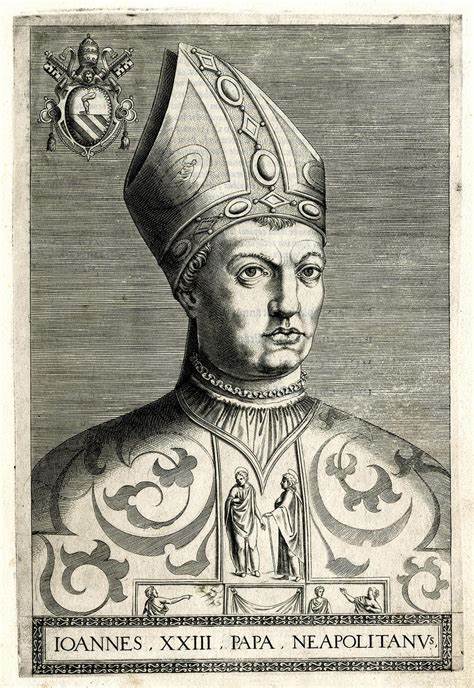
Baldassare Cossa was born around 1370, became “Pope” John XXIII in 1410 and died as Cardinal-Bishop of Tusculum on November 22, 1419.
Cossa was born on the island of Procida in the Kingdom of Naples. His father, Giovanni was the lord of the island, but was no longer a rich lord. As a young man, Cossa probably joined the military for a few years, but then attended the University of Bologna. While there he earned doctorates in both civil and canon law. At the same time, in 1386, he became canon of the cathedral. Ten years later he was archdeacon of the cathedral. He stayed at Bologna, teaching for a short time. Pope Boniface IX noticed him and invited Cossa to join in his service. At first, he stayed in Bologna but eventually moved to Rome. All this time, the Western Schism was in force, with two popes, one in Rome and one in Avignon.
In 1402, Cossa became cardinal deacon of St. Eustachius Church. The next year he was papal legate to Romagna. Cossa has been described in unflattering terms. He was said to be “utterly worldly-minded, ambitious, crafty, unscrupulous, and immoral. He had links to the robber gangs” in the area to intimidate his rivals. In other words, he acted like he was a member of the Mafia. Rumors were that he had many romantic partners.
When the new Roman pope, Gregory XII tried to nominate more cardinals, going against his promise to abdicate and do away with the schism, some of the old cardinals turned away. This included Cardinal Baldassare Cossa. A strong, domineering man, Cossa took a leadership role in the council the cardinals called in Pisa. The few cardinals from Rome and Avignon thought to end the schism. They voted to depose both Gregory of Rome and Benedict of Avignon. Both ignored the Pisan cardinals. Then they voted in a new “pope”, Alexander V.
Alexander lasted ten months before dying. Cossa was accused of poisoning Alexander, but nothing came of it. He was voted to replace Alexander, taking the name John XXIII. John got the Medici bank to become the papal bank. He joined with Louis II of Anjou, who wanted the kingdom of Naples, against Ladislaus, the ruler of Naples. After a battle, which Ladislaus won, Rome fell to the winner. Rome was not safe for John, so he and his cardinals ran up the coast to Florence. There he met Sigismund, the Holy Roman Emperor.
Sigismund wanted the schism to end. He urged John to hold a council, only not in Italy. In Germany, specifically Constance, on the German-Swiss border. John and Benedict were deposed. Gregory abdicated. John XXIII feared for his life, so he disguised himself, escaped the town via the Rhine, in the company of Sigismund’s right-hand man, Frederick IV, Duke of Austria.
On hearing of John’s escape, the town was in an uproar. They had plans for John involving jail time! Sigismund was furious that his plans went awry. Frederick was declared an outlaw, his lands and possessions forfeited. Battles were fought along the border and the Swiss Confederation won. By March 1415, John and Frederick got to Austria where Frederick was lord. But Sigimund’s men intercepted them and convinced them to return.
The ex-“Pope” John XXIII was tried on charges of simony, heresy, schism and immorality and found guilty on all charges. Later some charges were suppressed, and he was charged with piracy, rape, sodomy and incest. Imprisoned by Ludwig III, Elector of Palatine, John was eventually ransomed by the Medici bank.
After he got his freedom, John went to see Pope Martin in Florence. Within a few years, John became Cardinal Bishop of Tusculum. He died a few months later.
Internal link: POPE ALEXANDER V, A THIRD POPE AT THE SAME TIME! – Lanternarius Press
External link: POPE GREGORY XII, THE END OF THE WESTERN SCHISM (catholic365.com)

Recent Comments